The identity design work of Portland, OR firm
Jeff Fisher LogoMotives is represented in a big way in the new
Index Book release
Logos; From North to South America by Pedro Guitton. The Spanish publisher has included 46 of designer Jeff Fisher's logos in the 478-page volume, which contains hundreds of identity examples and comments about logo design from many of the professionals featured.

Small business logos from the designer featured in the book include that of his own business Jeff Fisher LogoMotives, and Portland businesses Balloons on Broadway, Big Daddy Marketing Specialties, Coyner's Auto Body, the Diva salon, greeting card company Good Pig - Bad Pig, retail development Heart of the Pearl and W.C. Winks Hardware. The identities for Harrison Flowers (Hood River, OR), Cooke Stationery (Salem, OR), writer Kimberly Waters (Seattle, WA), Kay Johnson's Sing Out Productions (Littleton, CO), the New England Firewood Company (Lancaster, MA), Walk Your Talk (Silver Springs, MD), Lone Star Site Design (Texas) and Buttonberry Books (Lebanon, NJ) were also showcased.
Education images exhibited in the volume include the logos for James John Elementary School in North Portland and the school's reading program, Buckman Elementary School's annual auction (Portland, OR), and an admissions program identity for George Fox University (Newberg, OR). Each year Fisher creates a graphic for the Fall Thesis celebration at Reed College (Portland, OR) and the images from 1999 through 2002 are in the book.
Organization logos for North Portland's Peninsula Clean Team, the Oregon Adult Soccer Association, the North Portland Business Association, the restoration campaign for the Vista House in Oregon's Columbia River Gorge and the Valles Caldera National Preserve in New Mexico are also highlighted. Gay/lesbian community identities in the book include those for Oregon Family OUTings (Eugene, OR) and the 2001 and 2003 logos for the annual Cascade Cup softball tournament.
The Hospice of Humboldt (Eureka, CA), Monroe Orthodontics (Aloha & Rainier, OR), the Seacoast AIDS Walk (Portsmouth, NH) and the designer's own safe sex message graphic A Rubber's Ducky are featured in the section on health-related logos.
Entertainment identities in the collection include several from the triangle productions! theatre company in Portland. Those include the play The Dream State, the company's 11th anniversary icon, the musical Naked Boys Singing, the 12th season image, and the shows When Pigs Fly, Veronica's Position, As Bees in Honey Drown, Caught in the Net, and Girls' Night Out. In addition, the logo for the Broadway Rose Theatre Company (Tigard, OR) production of Will Rogers Follies is presented.
Jeff Fisher has received nearly 500 regional, national and international graphic design awards for his logo and corporate identity efforts. His work is featured in more than 80 books on the design of logos, the business of graphic design, and small business marketing.
Fisher is a member of the HOW Magazine Editorial Advisory Board, the HOW Design Conference Advisory Council and the Board of Directors of Proscodi: Professional Society of Communication Design. His first book, The Savvy Designer's Guide to Success, was released by HOW Design Books in late 2004. He is currently writing "Identity Crisis," also for HOW Design Books, which is expected to be on bookshelves in 2007.
(* If I don't "toot!" my own horn, no one else will.)
© 2006 Jeff Fisher LogoMotives


















